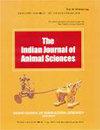Effect of olive pomace as supplement on growth, carcass and meat characteristics of Karadi lambs
IF 0.3
4区 农林科学
Q4 AGRICULTURE, DAIRY & ANIMAL SCIENCE
引用次数: 0
Abstract
This investigation aims to determine the effect of olive pomace on growth performance and quality of carcass characteristics of Karadi lambs. Lambs were grouped by initial body weights (29.746±1.49 kg) and randomly distributed into five groups. While one group received commercial concentrates without olive pomace, the second, third, fourth and fifth groups received an experimental diet containing 4, 8, 12 and 16% of olive pomace, respectively. The lambs’ body weight, feed intake and feed conversion ratio were recorded weekly. At 46 kg live body weight, three lambs from each group were slaughtered in order to record carcass and non-carcass characteristics. Lambs fed olive pomace had significantly higher average daily gain and feed conversion ratio than those fed on the control diet. The experimental groups also produced carcass yield mainly due to an increase in carcass weight. Lambs fed 12% olive pomace had significantly higher rib eye area and fat thickness. The wholesale cuts showed that lambs fed olive pomace had significantly higher shoulder and shank percentage and significantly lower loin percentage than those of the lambs fed on the control diet. Most carcass cuts of lambs fed 8% olive pomace recorded significantly higher percentage of lean. Overall, supplementation with olive pomace significantly improved lamb growth and showed its capacity for meat production.添加橄榄渣对卡拉迪羔羊生长、胴体和肉品质的影响
本试验旨在研究橄榄渣对卡拉迪羔羊生长性能和胴体品质的影响。羔羊按初始体重(29.746±1.49 kg)分组,随机分为5组。第一组饲喂不含橄榄渣的商业浓缩物,第二组、第三组、第四组和第五组分别饲喂含有4、8、12和16%橄榄渣的试验饲粮。每周记录羔羊体重、采食量和饲料系数。在46 kg活重时,每组屠宰3只羔羊,记录胴体和非胴体特征。饲喂橄榄渣的羔羊平均日增重和饲料系数显著高于对照组。试验组主要通过增加胴体重来提高胴体产量。饲喂12%橄榄渣的羔羊肋眼面积和脂肪厚度显著增加。批发屠宰结果表明,饲喂橄榄渣的羔羊肩、小腿比例显著高于对照组羔羊,腰肉比例显著低于对照组羔羊。饲喂8%橄榄渣的羔羊胴体肉的瘦肉比例显著提高。总体而言,补充橄榄渣显著改善了羔羊的生长,并显示出其生产肉类的能力。
本文章由计算机程序翻译,如有差异,请以英文原文为准。
求助全文
约1分钟内获得全文
求助全文
来源期刊

Indian Journal of Animal Sciences
农林科学-奶制品与动物科学
CiteScore
0.60
自引率
25.00%
发文量
220
审稿时长
8 months
期刊介绍:
Articles published in The Indian Journal of Animal Sciences encompass a broad range of research topics in animal health and production related to cattle, buffalo, sheep, goat, camel, equines, pig, rabbit, yak, mithun, poultry and fisheries. Studies involving wildlife species and laboratory animal species that address fundamental questions about their biology will also be considered for publication. All manuscripts must present some new development and must be original, timely, significant and scientifically excellent. Papers will be rejected if standards of care of, or procedures performed on animals are not up to those expected of humane veterinary scientists. At a minimum, standards must meet the International Guiding Principles for Biomedical Research involving Animals, as issued by the Council for International Organizations of Medical Sciences. (C.I.O.M.S., c/o WHO, CH 1211 Geneva 27, Switzerland). Articles reporting new animal disease must follow GOI directive as given in detail in Guidelines to Authors.
 求助内容:
求助内容: 应助结果提醒方式:
应助结果提醒方式:


